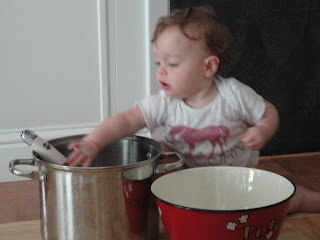This Week's Foci: Language and Life Skills
Interactions with Materials
Interactions with Materials
- Q-ball now has her favorite books memorized. She's quick to skip to her favorite parts (the only part of The Hungry Caterpillar that we read is what he ate on Sunday..) and gets so excited that she'll anticipate what is coming next.
- She's still really interested in clocks and looks for them or watches wherever we go, so she can practice her "Tick Tock."
- She really enjoyed working with her stacking tree this week. It took her a few days, but now she will sit with it, very focused, for quite a few awhile (i.e.- a few minutes.)
- She finally seems to have found a "lovey" or two! One is a little blanket that her Great Aunt L made her. We started giving it to her at sleep times, and now she always looks for it. The other is her new pillow. She's still trying to figure out how to use it, but she loves hugging it!
Interactions with Others
- We have been trying to get Q-ball to stay in the nursery during church. Of course, we didn't think it would happen overnight, and we were right. It's been two weeks now, and she is certainly not happy to stay with the lady at the nursery. The phrase from last Sunday was "screaming bloody murder." And, she was only left alone without Mama or Daddy for a few minutes.
- But, she does enjoy playing with people if Mama and Daddy are close. She quickly recruited another parent to play ball with her at our most recent park day.
- She loves her Daddy! She knows when it is almost time for him to come home, and she starts to get impatient. Then, when I tell her he's coming, she runs for the door, and chants "Daddy, Daddy!" while making the corresponding sign.
Interactions with Space
- She's become quite the runner around the house!
Interactions with Life
- Q-ball is really experimenting with sign language now. I can't always tell what she is trying to say as she either mixes up some signs or blurs over some of the movements. But, she's continuing to try, and we have had quite a bit of success this week.
- Since getting the floor bed, I believe that she wants to put herself to sleep at night or at least be laying on her floor bed (and on her pillow!) instead of in Mama's arms. But, she hasn't quite figured it out. We've spent about 45-60 minutes of the past few nights trying to get it right, but we end up in Mama's arms in the end. I'll be interested to see how this pans out.
To see the rational and purpose for the Watch Her Grow series, please check out this post!




















